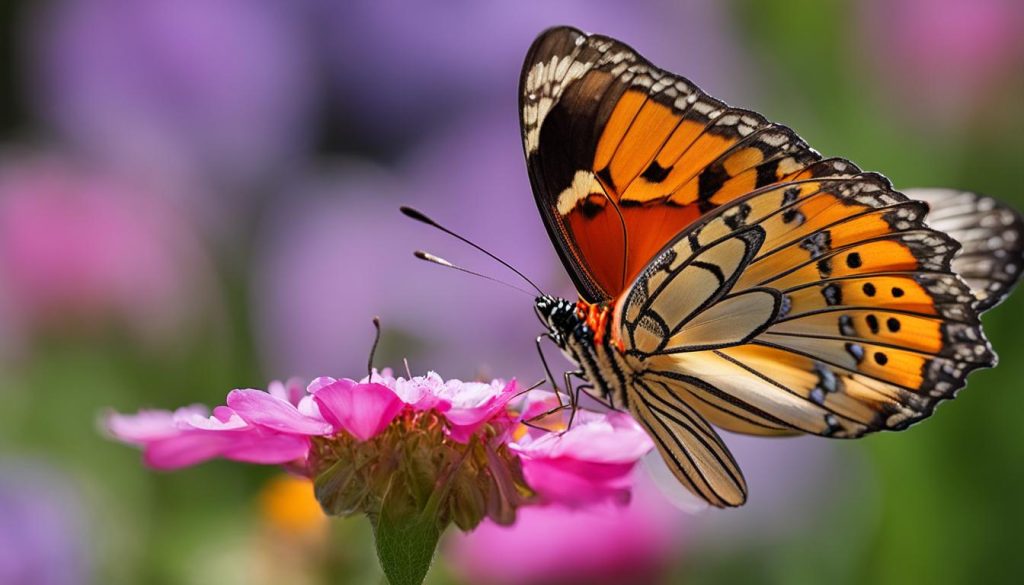Butterflies are fascinating creatures, known for their vibrant colors and graceful flight. Yet, there’s something even more extraordinary about these delicate insects – their ability to taste with their feet. Yes, you read that right! Butterflies have taste receptors on their feet, allowing them to experience the flavors of the world around them in a truly unique way.
Just imagine, as butterflies land on flowers or leaves, their tiny chemoreceptors, similar to taste buds in humans, come into play. These receptors enable butterflies to determine the sweetness of flowers or the bitterness of leaves, guiding their feeding behavior and survival strategies.
This close-up image captures a butterfly delicately extracting nectar from a flower using its proboscis, a long tubular tongue-like structure found in many butterfly species. While the proboscis aids in feeding, it is the intricate sensory organs in a butterfly’s legs and feet that truly provide a sensory wonder.
Key Takeaways:
- Butterflies possess taste receptors on their feet, allowing them to taste their surroundings.
- This unique adaptation helps butterflies identify suitable food sources for themselves and their caterpillars.
- Female butterflies also use their feet to taste leaves and determine if they are suitable for egg-laying.
- Tasting with their feet is crucial for the survival and reproductive success of butterflies.
- The sensory abilities of butterflies highlight their intricate adaptations and make them even more awe-inspiring.
How Do Butterflies Use Their Taste Sensors?

Butterflies have fascinating food preferences and a highly developed gustatory system that allows them to navigate their environment with precision. Their taste buds, located on their feet, play a crucial role in their survival and reproductive success.
Primarily, butterflies rely on nectar as their main source of sustenance. Nectar is a sugar-rich liquid produced by flowers. To ensure they find the sweetest and most energy-rich sources of nectar, butterflies use their taste sensors on their feet. These sensors, similar to taste buds in humans, can detect dissolved sugars, enabling butterflies to locate nectar-bearing flowers effectively.
Female butterflies also utilize their taste sensors for another important purpose – choosing the ideal plant on which to lay their eggs. By tasting the leaves, they can determine if the plant is suitable for their caterpillar offspring to feed on. This remarkable adaptation ensures that the next generation of butterflies has access to appropriate food sources from the very beginning of their lives.
Overall, the gustatory system and taste buds on a butterfly’s feet are essential tools that allow them to identify the most nutritious nectar and suitable plants for their offspring. This remarkable adaptation demonstrates the intricate and remarkable nature of butterflies’ sensory abilities.
Butterflies possess a remarkable ability to taste their environment using their feet and their gustatory system. By leveraging their taste sensors and taste buds, they can make informed decisions about their feeding behavior and reproductive choices. Their unique adaptation allows butterflies to flourish in diverse habitats and adds to the wonder and charm of these delicate creatures.
The Fascinating Adaptations of Butterflies
The ability of butterflies to taste with their feet is just one example of the fascinating adaptations they possess. These delicate creatures, known for their beautiful wings and enchanting flight, carry within their tiny feet an evolutionary marvel. Their sensory organs, specifically the taste receptors on their legs and feet, allow them to explore and taste their environment as they walk.
Butterflies have evolved this unique sensory system to help them navigate their surroundings and find suitable sources of food and shelter. By utilizing their butterfly sensory organs, they can detect the subtle chemical cues present on flowers or leaves, providing them with important information about their environment.
This remarkable insect taste perception allows butterflies to identify appropriate nectar-bearing flowers, ensuring a steady supply of energy-rich food. Additionally, female butterflies use their taste receptors to assess the suitability of leaves for their caterpillar offspring to feed on, playing a crucial role in the survival and development of the next generation.
By understanding the intricate adaptations of butterflies, including their gustatory system and sensory organs, we gain a deeper appreciation for these vibrant insects. Their ability to taste with their feet and perceive their environment through chemoreceptors is a testament to the wonders of evolution and the incredible diversity of life on Earth.
FAQ
How do butterflies taste their food?
Butterflies taste their food by using tiny taste sensors called chemoreceptors on their feet, similar to taste buds in humans.
What is the purpose of butterfly taste receptors?
The taste receptors on butterflies’ feet help them identify the sweetness of flowers or the bitterness of leaves, allowing them to find nectar-bearing flowers and suitable leaves for laying eggs.
What do butterflies primarily feed on?
Butterflies primarily feed on nectar, a sugar-rich liquid produced by flowers.
How do butterflies choose their food sources?
Butterflies choose their food sources by detecting dissolved sugars with the taste sensors on their feet, allowing them to find the sweetest and most energy-rich sources of nectar.
How do female butterflies use their taste sensors?
Female butterflies use their taste sensors to taste leaves and determine if they are suitable for their caterpillar offspring to feed on. They use this information to choose the perfect plant on which to lay their eggs.
What role does the gustatory system of butterflies play in their survival and reproductive success?
The gustatory system, including the taste buds on butterflies’ feet, plays a crucial role in their survival and reproductive success. It helps them find suitable food sources and determine ideal plants for their caterpillar offspring to feed on.
What other fascinating adaptations do butterflies have?
Butterflies possess various sensory organs, including taste receptors on their legs and feet, which allow them to explore and taste their environment as they walk.
How do butterflies continue to amaze us with their unique abilities?
From their gustatory system to their sensory organs, butterflies reveal intricate adaptations that deepen our appreciation for these vibrant insects.






